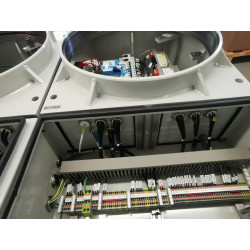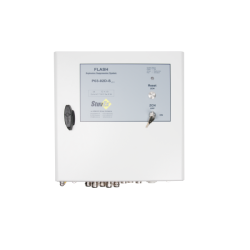-
BackX
-
Components
-
-
Category
-
Semiconductors
- Diodes
- Thyristors
-
Electro-insulated Modules
- Electro-insulated Modules | VISHAY (IR)
- Electro-insulated Modules | INFINEON (EUPEC)
- Electro-insulated Modules | Semikron
- Electro-insulated Modules | POWEREX
- Electro-insulated Modules | IXYS
- Electro-insulated Modules | POSEICO
- Electro-insulated Modules | ABB
- Electro-insulated Modules | TECHSEM
- Go to the subcategory
- Bridge Rectifiers
-
Transistors
- Transistors | GeneSiC
- SiC MOSFET Modules | Mitsubishi
- SiC MOSFET Modules | STARPOWER
- Module SiC MOSFET ABB’s
- IGBT Modules | MITSUBISHI
- Transistor Modules | MITSUBISHI
- MOSFET Modules | MITSUBISHI
- Transistor Modules | ABB
- IGBT Modules | POWEREX
- IGBT Modules | INFINEON (EUPEC)
- Silicon Carbide (SiC) semiconductor elements
- Go to the subcategory
- Gate Drivers
- Power Blocks
- Go to the subcategory
- Electrical Transducers
-
Passive components (capacitors, resistors, fuses, filters)
- Resistors
-
Fuses
- Miniature Fuses for electronic circuits - ABC & AGC Series
- Tubular Fast-acting Fuses
- Time-delay Fuse Links with GL/GG & AM characteristics
- Ultrafast Fuse Links
- Fast-acting Fuses (British & American standard)
- Fast-acting Fuses (European standard)
- Traction Fuses
- High-voltage Fuse Links
- Go to the subcategory
- Capacitors
- EMI Filters
- Supercapacitors
- Power surge protection
- TEMPEST emission revealing filters
- Surge arrester
- Go to the subcategory
-
Relays and Contactors
- Relays and Contactors - Theory
- 3-Phase AC Semiconductor Relays
- DC Semiconductor Relays
- Controllers, Control Systems and Accessories
- Soft Starters and Reversible Relays
- Electromechanical Relays
- Contactors
- Rotary Switches
-
Single-Phase AC Semiconductor Relays
- AC ONE PHASE RELAYS 1 series| D2425 | D2450
- One phase semiconductor AC relays CWA and CWD series
- One phase semiconductor AC relays CMRA and CMRD series
- One phase semiconductor AC relays - PS series
- Double and quadruple semiconductor AC relays - D24 D, TD24 Q, H12D48 D series
- One phase semiconductor relays - gn series
- Ckr series single phase solid state relays
- One phase AC semiconductor relays for DIN bus - ERDA I ERAA series
- 150A AC single phase relays
- Rail Mountable Solid State Relays With Integrated Heat Sink - ENDA, ERDA1 / ERAA1 series
- Go to the subcategory
- Single-Phase AC Semiconductor Relays for PCBs
- Interface Relays
- Go to the subcategory
- Cores and Other Inductive Components
- Heatsinks, Varistors, Thermal Protection
- Fans
- Air Conditioning, Accessories for Electrical Cabinets, Coolers
-
Batteries, Chargers, Buffer Power Supplies and Inverters
- Batteries, Chargers - Theoretical Description
- Modular Li-ion Battery Building Blocks, Custom Batteries, BMS
- Batteries
- Battery Chargers and Accessories
- Uninterruptible Power Supply and Buffer Power Supplies
- Inverters and Photovoltaic Equipments
- Energy storage
- Fuel cells
- Lithium-ion batteries
- Go to the subcategory
-
Automatics
- Spiralift Lifts
- Futaba Drone Parts
- Limit Switches, Microswitches
- Sensors, Transducers
-
Infrared Thermometers (Pyrometers)
- IR-TE Series - Water-proof Palm-sized Radiation Thermometer
- IR-TA Series - Handheld Type Radiation Thermometer
- IR-H Series - Handheld Type Radiation Thermometer
- IR-BA Series - High-speed Compact Radiation Thermometer
- IR-FA Series - Fiber Optic Radiation Thermometer
- IR-BZ Series - Compact Infrared Thermometers
- Go to the subcategory
- Counters, Time Relays, Panel Meters
- Industrial Protection Devices
- Light and Sound Signalling
- Thermographic Camera
- LED Displays
- Control Equipments
- Go to the subcategory
-
Cables, Litz wires, Conduits, Flexible connections
- Wires
- Cable feedthroughs and couplers
- Litz wires
- Cables for extreme applications
- Sleevings
-
Braids
- Flat Braids
- Round Braids
- Very Flexible Flat Braids
- Very Flexible Round Braids
- Cylindrical Cooper Braids
- Cylindrical Cooper Braids and Sleevings
- Flexible Earthing Connections
- Galvanized and Stainless Steel Cylindrical Braids
- PCV Insulated Copper Braids (temp. up to 85C)
- Flat Aluminium Braids
- Junction Set - Braids and Tubes
- Go to the subcategory
- Traction Equipment
- Cable Terminals
- Flexible Insulated Busbars
- Flexible Multilayer Busbars
- Cable Duct Systems
- Go to the subcategory
- View all categories
-
Semiconductors
-
-
- Suppliers
-
Applications
- CNC Machine Tools
- DC and AC Drives (Inverters)
- Energetics
- Energy bank
- Equipment and Components for Hazardous Areas [Ex]
- Equipment for Distribution, Control and Telecommunications Cabinets
- HVAC Automation
- Induction Heating
- Industrial Automation
- Industrial Protective Devices
- Machines for Drying and Wood Processing
- Machines for Thermoforming Plastics
- Mining, Metallurgy and Foundry
- Motors and Transformers
- Power Supplies (UPS) and Rectifier Systems
- Printing
- Temperature Measurement and Regulation
- Test and Laboratory Measurements
- Tram and Railway Traction
- Welding Machines
-
Assembly
-
-
Inductors
-
-
Induction devices
-
-
Service
-
- Contact
- Zobacz wszystkie kategorie
(Preventive) Explosion Protection Measures

How to ensure explosion protection in the event of an explosion?
In many cases, it is impossible to avoid explosive atmospheres and ignition sources due to technological or process limitations within the facility. Therefore, appropriate measures must be taken to limit the effects of an explosion to an acceptable level – ideally, to zero.
Secondary explosion protection includes
- explosion-resistant structures,
- explosion vents,
- explosion suppression systems,
- methods for preventing the spread of flames and secondary explosions.
These measures primarily address the limitation of the hazardous effects of explosions originating in installations. Protective equipment and systems that meet the requirements of Directive 94/9/EC are typically used as containment measures. Structural measures, such as protective pillars, partitions, embankments, etc., can also be used.
Explosion-resistant equipment
Plant components, such as containers, vessels, and pipes, are designed to withstand an internal explosion without rupturing. The initial pressure in a system component must be taken into account if it differs from normal atmospheric pressure.
Generally, a distinction is made between types of explosion-resistant designs. These include:
- designs resistant to the maximum explosion overpressure
or - designs resistant to reduced explosion overpressure associated with its release or suppression.
A system design can be resistant to explosion pressure or to explosion pressure surge.
Explosion Relief
In a broad sense, "explosion relief" encompasses all means of enabling, in the event of an explosion occurring or spreading to some extent, the brief or sustained opening, in a direction that does not pose a hazard, of a closed system in which an explosion has occurred, once the pressure that activates the release device is reached. The purpose of an explosion relief device is to ensure that the system is not exposed to the risk of an explosion exceeding its strength. The result of this action is a value known as reduced explosion overpressure.
Examples of explosion relief devices
Examples of devices that can be used as "explosion relief devices" include bursting discs and explosion relief valves. Safety-related mixture parameters must be determined to calculate the required relief area for the installation. Explosion relief is not permitted if it could result in the release of substances that pose a hazard to humans or the environment (e.g., the release of toxic substances).
Explosion Suppression
Explosion suppression systems prevent the maximum explosion pressure from reaching by rapidly introducing extinguishing agents into containers and systems in the event of an explosion. Components protected in this way must be designed to withstand only the reduced explosion pressure. Unlike an explosion escape, this ensures that the effects of an explosion are contained within the container. Depending on the design, the explosion overpressure can be reduced to 0.2 bar.
Preventing Explosion Propagation (Technical Isolation)
An explosion occurring in one part of the system can propagate to the upper or lower parts, where it can trigger further explosions. The acceleration effect caused by system components or propagation in pipework can intensify its effects. The resulting explosion pressure can be much higher than the maximum pressure under normal conditions and can destroy system components, even if their design is resistant to explosion pressure or pressure surge. Therefore, it is important to limit the probable explosion to individual system components. This can be achieved through technical isolation using:
- quick-acting mechanical isolation,
- extinguishing flames in narrow gaps or by introducing an extinguishing agent,
- stopping flames using a powerful countercurrent,
- water shutoff,
- rotary valves.
The explosion protection measures described above are maintained, monitored, and activated by safety, control, and regulatory devices. In general, fire protection devices can be used to prevent the occurrence of hazardous explosive atmospheres or ignition sources, or to limit the harmful effects of an explosion. Potential ignition sources, such as hot surfaces, can be monitored by fire protection devices and controlled to ensure that a safe value is not exceeded.
Potential ignition sources can also be shut down if a hazardous explosive atmosphere occurs. For example, a non-explosion-resistant device can be shut down if a gas detector is activated if this prevents potential ignition sources from occurring within the device. The occurrence of hazardous explosive atmospheres can be prevented, for example, by starting a fan before the maximum permissible gas concentration is reached. The use of fire alarm systems (SSP) can reduce the size of hazardous areas and prevent or reduce the likelihood of a hazardous explosive atmosphere occurring. Combined with solutions designed to limit the harmful effects of explosions, SSP devices constitute protective systems, such as explosion suppression systems. The design and range of these SSP devices, as well as the measures they trigger, depend on the likelihood of hazardous explosive atmospheres and effective ignition sources. The reliability of SSP devices, combined with the implemented technical and organizational measures, must ensure that the explosion hazard is limited to acceptable levels under all operating conditions. In some cases, it could be useful to combine SSP devices for preventing ignition sources with SSP devices for preventing the formation of hazardous explosive atmospheres.
Related products
Related posts
 Now available – DC/DC converters from PREMIUM
Now available – DC/DC converters from PREMIUM
 New release in DACPOL lighting for lathes – Kira covers
New release in DACPOL lighting for lathes – Kira covers









Leave a comment